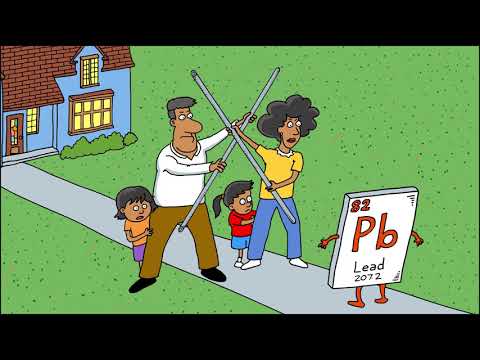Lead Communications


Lead Communications
Frequent and transparent communication is key to keeping communities informed and safe from lead in pipes and plumbing. AWWA provides resources to help utilities communicate with customers about lead while managing regulatory requirements, including those in the U.S. Environmental Protection Agency’s (EPA) Lead & Copper Rule Revisions (LCRR) and the Lead & Copper Rule Improvements (LCRI).
Learn more from our Lead Communications Guide and Toolkit, which includes customizable outreach templates and water sector communication examples addressing the LCRR. View video interviews with water utility experts from Halifax Water, City of Newark and Green Bay Water, as well as a strategic communicator from HDR and the chair of our Lead and Copper Rule Advisory Committee. Download a customizable messaging tool and a series of articles about complying with the LCRR and LCRI from AWWA’s member newsletter, Connections.
EPA established the Lead and Copper Rule in 1991 to reduce exposure to lead and copper in water. These contaminants primarily enter drinking water through corrosion of service lines, fixtures, or plumbing. EPA has revised this rule multiple times since 1991.
The LCRR was implemented Oct. 16, 2024. The final LCRI was announced Oct. 8, 2024. It maintains some of the LCRR requirements and includes additional improvements for later implementation. Some of the topics addressed in the rules include:
- Lead service line inventories
- Annual lead service line notification requirement
- Lead service line replacement plan
- Trigger levels, sampling, action level exceedances and water disturbances
- Public health effects language
- Outreach to state and local health agencies
- Updated information in Consumer Confidence Reports
- Testing at schools and childcare facilities

Animated Whiteboard Aids Consumer Understanding
AWWA’s animated whiteboard explainer helps consumers understand how to protect their households from the risk of lead in drinking water. The three-minute animation advises consumers to work with a plumber to identify sources of lead and whenever possible, to “get the lead out.” Some older homes have lead service lines or plumbing fixtures, fittings and solder that contain lead.
Consumer Tools
The downloadable tools below include both adaptable text and completed, printable items. In all cases, they should be reviewed carefully to assure the information provided is consistent with local circumstances.
Advertisement
Outreach to Customers

Transparency
A principle of effective risk communication is to be open and honest, even when you don’t have all the answers. Utilities that actively share information about lead risks, lead service lines and sampling results build trust and credibility with customers.
Utility LSL Mapping Samples
Communicating Without All the Answers
One of the more difficult aspects of communicating with customers and other stakeholders about lead is the fact that there are often unanswered questions. Given the age and composition of many water systems, it may be impossible to fully account for every lead service line. That should not dissuade utilities from communicating openly and fully about the potential presence of lead service lines in the communities they serve.
The Lead Service Line Replacement Collaborative provides guidance for water utilities as they prepare inventories of lead service lines in their service areas.
Extent of Known Lead Service Line Inventory
While most water utilities do not have a searchable, complete inventory of lead service lines in their communities, many have made inroads in identifying specific areas of concern based upon construction age or information gleaned from on-site inspections. Sharing that information with customers demonstrates transparency. Where feasible, visual depictions of the utility’s service area highlighting areas of likely lead service lines should be utilized.
While many variables (i.e. such as the age of the distribution system, quality and quantity of available records, staff resources to identify lead in the field and through records, etc…) determine how much utilities know about the presence of lead service lines in their service areas, most utilities fall into one of three categories:
Very little to no information available (DOC)
Service line inventory under way (DOC)
Service line composition well understood (DOC)
The language options available above are designed to provide general guidance to help utilities communicate what is known and not known about lead service lines, and in so doing, reinforce that the utility is concerned about its customers’ health and is ready to work with them to solve this issue. They may be easily customized to suit a utility’s individual situation.
Sampling Protocols and SDWA Rules
While a utility may not be able to tell a specific customer whether lead is present in their water supply, the fact that water suppliers systematically test for lead may be reassuring to many customers and reinforce the fact that utilities put customers’ health first. Explaining—in non-technical language—the concept behind the Lead and Copper Rule and the testing required of utilities is a good first step. In particular, utilities should be candid about the meaning of “action levels” and clearly articulate the results of testing.
Status of Lead Reduction Efforts
For utilities with known lead service lines in their distribution systems, the question may arise, “Why haven’t they all been removed?” As utilities know, replacing service lines is both time-consuming and expensive.
While some entities are reluctant to talk about financial considerations, customers are far more understanding when utilities explain that it is ratepayers’ money being spent, and that—even if it were feasible from a project management perspective—an undertaking of that magnitude would likely result in significant rate increases.
Sharing information about mitigation measures such as corrosion control programs and reassuring customers that the utility is systematically removing and replacing lead service lines reinforces its commitment to protecting residents while managing costs.
A Call for Transparency
In February 2016, the EPA’s Office of Water issued a memorandum to all EPA Region directors that emphasized the importance of transparency on every level so the American public has enough information to make informed health decisions.
A specific near-term action EPA asked of states is that they “work with public water systems – with a priority emphasis on large systems – to increase transparency in implementation of the LCR by posting on their public website and/or on your agency’s website:
- the materials inventory that systems were required to complete under the LCR, including the locations of lead service lines, together with any more updated inventory or map of lead service lines and lead plumbing in the system; and
- LCR compliance sampling results collected by the system, as well as justifications for invalidation of LCR samples”
“Continuing to enhance public transparency and accountability is critical to reassure the public of our continuing work to protect the nation’s drinking water.”
– Joel Beauvais, Former Deputy Assistant Administrator, EPA
As all utilities should know, the Lead and Copper Rule has specific public outreach provisions that are triggered by lead occurrence in drinking water. All indications are that the revised Lead and Copper Rule will build upon those requirements and require customer outreach by utilities, even if there has been no trigger of the LCR action level.
Engaging Partners
Water providers are important sources of information about lead in drinking water—but they’re not the only ones. People in need of solutions will look to a variety of sources to find them, and not always the ones you would expect. Although water utilities should expect to play a lead role in communicating with their customers, there are many benefits in collaborating with other potential information sources.
To the right is a brief list of stakeholders who may complement or amplify a water supplier’s outreach on lead in drinking water:
And below are free resources for utilities to use to communicate with stakeholders that include public officials, plumbers, public health agencies, realtors and others.
Public Health Officials
Whether at the city, county or state level, these officials are generally trusted and viewed as independent. While they shouldn’t be expected to lead the messaging effort, it is important that the information they provide be consistent with that shared by water providers.
Local Regulatory Agencies
Discord between a water utility and its oversight agency can be disastrous. Both communications and technical staff should coordinate to ensure consistency.
Neighboring Water Systems
A single “media market” often encompasses numerous water systems. Proactively discussing the issue of lead with peer agencies and consecutive systems is the best way to prevent confusion.
Community Building/Permitting Officials
Although their roles generally have little to do with water quality, it is important to remember that lead is at its roots is a construction materials issue. Apprising building professionals of premise plumbing issues and water utility actions and messages can broaden your reach and avoid contradictory information.
Real Estate Professionals/Home Inspectors
The transfer of property represents an opportunity to replace lead service lines and address other lead plumbing issues. Communicating about lead with those involved in home inspections and real estate transactions encourages transparency that may reduce risks for some households.
Elected Officials
Often the first stops for concerned residents, public officials and their liaisons field constituent questions every day. Prepare them by providing background information and a resource to whom they can direct more detailed inquiries.
School System Representatives
This stakeholder group is important enough to warrant its own section, “Help Schools.” Charged with protecting a young and vulnerable population, school officials can be strong advocates if properly informed.
Plumbing Professionals
Often overlooked as stakeholders, plumbers are a go-to resource for homeowners trying to determine whether they may have a lead issue. Reaching out to them early increases the likelihood that they will help their clients make informed decisions.
Water and Consumer Advocates
Proactively reaching out to stakeholders who advocate for water safety and consumer protections encourages a spirit of collaboration and demonstrates authentic interest in public health. Water providers are uniquely qualified to provide accurate information to groups that communicate separately with their customers.
Media
Engaging local media and online influencers is key to defining lead issues. Clearly communicating the nature of the issue – before there is a news story about lead in water – is critical to prevent misinformation and demonstrate transparency.
Opportunities for Water Utilities to Collaborate with Schools/Daycares to Address Lead in Plumbing
As part of their mission to protect public health, water utilities can help administrators of schools and childcare facilities better understand how to protect children in their care.
Resources for Reaching out to School and Child Care Administrators
Many older facilities have lead materials in their plumbing and fixtures. U.S. EPA stresses that a number of factors unique to these facilities are cause for concern:
- The extended periods of time children spend in school and child care facilities.
- The age of buildings, plumbing and fixtures that are subject to corrosion and the leaching of lead into drinking water.
- The on again/off again water use patterns that promote corrosion as water stands in plumbing pipes when it’s not in use.
Below are a number or resources to help water utilities reach out schools and child care facilities and encourage them to take an active approach to protecting children from lead in water.
Help the School / Child Care Understand the Source of Lead in Drinking Water
A school or child care facility administrator may benefit from a better understanding of how lead leaches from facility plumbing. As a utility, you may choose to provide information on water quality factors affecting the water’s corrosivity. You may also explain your corrosion control program to affirm your utility’s commitment to minimizing lead exposure at the tap. Simply providing your Consumer Confidence Report (CCR) may be helpful.
Developing a Sampling Plan
Water quality sampling is a familiar task for drinking water suppliers, but not for most schools and child care facilities. Some utilities have informed appropriate school staff about the critical elements of a sound sampling plan. Those elements include identifying and tracking sample locations, proper timing of sample events, sampling protocols and management of sample results.
Proper Sample Collection
Proper sampling technique is essential to obtaining correct lead sample results. Some utilities have assisted school systems and child care facilities in proper sampling protocols. This assistance may include direct participation in training events or a train-the-trainer technical assistance strategy.
Laboratory Services
Water suppliers may provide information on lab services needed for processing lead samples. Assistance in this area has taken a number of forms, including explaining the appropriate analytical methods, identifying certified laboratories and assisting in selection of laboratory services. In some cases, utilities have provided analytical services through their in-house laboratories.
Reviewing Results and Options to Control Lead Exposure
As a water supplier, you may have personnel available to interpret sample results and identify cost-effective control solutions. Utility staff is trained in the basic issues of corrosion chemistry and hydraulics. They also have practical experience operating water distribution facilities, flushing pipe networks, installing automated valves, and employing other procedures unfamiliar to most school and child care personnel.
Utility Assistance in a Targeted Evaluation Effort
In school districts with multiple buildings dedicated to teaching, the water utility may offer support in evaluating lead levels in a limited or targeted group of facilities. For example, the utility might help a school system develop a pilot approach to evaluating its facilities. If successful, the school staff would then apply that approach to other facilities. The utility may also assist in identifying the characteristics of buildings that make them especially vulnerable to elevated levels of lead in the drinking water.
Large-Scale Involvement in Lead Action Plan
Depending on local circumstances (especially governance), a water utility may choose to become deeply involved in addressing school system or child care facility lead action plans. For example, the utility may be an active participant in a stakeholder.
Understanding EPA’s 3Ts Program
U.S. EPA released an updated 3Ts for Reducing Lead in Drinking Water toolkit to provide guidance and resources for schools, child care facilities, states and water systems to implement voluntary lead in drinking water testing programs. The 3Ts are training, testing and taking action.
The toolkit contains customizable templates, supplemental fact sheets and checklists. It’s organized into section sections:
- Communicating the 3Ts
- Learning About Lead in Drinking Water
- Planning Your 3Ts Program
- Developing a Sampling Plan
- Conducting Sampling and Interpreting Results
- Remediation and Establishing Routine Practices
- Recordkeeping
In partnership with AWWA and various other organizations, U.S. EPA released a Memorandum of Understanding (MOU) on Reducing Lead Levels in Drinking Water in Schools and Child Care Facilities. The MOU provides a framework for a coordinated approach between partner organizations to focus on testing for and addressing lead in drinking water for schools and childcare facilities.
Advertisement
